- What happened: Oak Ridge National Laboratory (ORNL) 3D‑printed two 316H stainless‑steel irradiation capsules using laser powder‑bed fusion (LPBF), inserted them into the High Flux Isotope Reactor (HFIR) for ~1 month, and removed them fully intact—a milestone showing additively manufactured hardware can meet nuclear‑safety performance in‑core. ornl.gov
- Why it matters: The capsules serve as sealed, pressure‑containing barriers that hold test materials during neutron irradiation—so proving a printed capsule can survive HFIR conditions is a high bar for safety‑critical nuclear service and a gateway to printed parts elsewhere in reactors. ornl.gov
- How “tough” is the test? HFIR operates at 85 MW and provides among the world’s highest steady‑state neutron fluxes; peak thermal flux in the central flux trap is ≈2.5×10¹⁵ n·cm⁻²·s⁻¹, with strict heat‑flux limits ~2.3×10⁵ W·m⁻² on capsule surfaces. Neutron Sciences
- Pressure integrity: ORNL pressure‑tested printed capsules to 6,000 psi before insertion and reports all units maintained structural integrity after weeks in HFIR. ornl.gov
- Precedent (Jan 15–16, 2025): ORNL also designed, printed, and irradiated the first 3D‑printed “rabbit” capsule for HFIR’s hydraulic tube—another “first‑of‑a‑kind” endurance check under high‑flux conditions. The Department of Energy’s
- Bigger picture: ORNL’s Manufacturing Demonstration Facility (MDF) is using 3D printing across the nuclear lifecycle—from in‑reactor brackets installed at TVA’s Browns Ferry to composite formwork that compresses concrete‑mold lead times for the Kairos Power Hermes demonstration reactor from weeks to days. ornl.gov, Department of Energy’s
The future of the atom, additively manufactured
When nuclear engineers call something “the toughest test on Earth,” they’re talking about sustained neutron bombardment inside a research reactor. Neutrons displace atoms, generate gas, drive microstructural changes, embrittle metals, and can swell and creep alloys in ways no other environment can fully replicate. ORNL’s HFIR is built to deliver exactly that stressor—one of the world’s highest steady‑state neutron fluxes—which is why it’s where materials and components go to prove themselves. Neutron Sciences
On July 18, 2025, ORNL reported that two LPBF‑printed 316H stainless‑steel capsules endured about a month of irradiation at HFIR and were removed intact. The capsules’ job is deceptively simple but safety‑critical: hold test specimens, contain gases and pressure, and keep the reactor clean while exposing the payload to the full neutron spectrum. Surviving that assignment as a 3D‑printed structure is the point. ornl.gov
What, exactly, passed the test?
- Component: Sealed irradiation capsules (pressure/containment vessels for in‑core experiments).
- Material: 316H stainless steel, selected for high‑temperature strength, corrosion and radiation resistance, and established performance in nuclear service.
- Process: Laser powder‑bed fusion (LPBF) at ORNL’s Manufacturing Demonstration Facility (MDF); assembled and qualified by ORNL’s Irradiation Engineering group. ornl.gov
Prior to insertion, ORNL pressure‑tested the printed capsules to 6,000 psi to verify leak‑tightness and structural margin; after weeks in HFIR, the capsules retained integrity, underscoring that LPBF hardware can meet containment and pressure boundary duties in the core. ornl.gov
Why HFIR is a uniquely punishing gatekeeper
HFIR is a 85‑MW, light‑water‑cooled, beryllium‑reflected “flux‑trap” reactor whose design concentrates thermal neutrons in a central island to maximize flux. In that region, peak thermal flux is ~2.5×10¹⁵ n·cm⁻²·s⁻¹, a level that accelerates damage accumulation (displacements‑per‑atom, or dpa) and gives rapid, statistically significant results. HFIR also enforces surface heat‑flux limits (~2.3×10⁵ W·m⁻²) on capsules to maintain safe thermal margins—constraints that printed capsules must satisfy by design. Neutron Sciences
HFIR’s hydraulic tube (rabbit) facility enables sub‑cycle irradiations by shuttling sealed mini‑capsules to/from the core during operation—a proving ground ORNL used in January 2025 to run the first 3D‑printed rabbit capsule for nearly a month. Neutron Sciences
Design and manufacturing details that matter
- Alloy rationale—316H: Compared with 316/316L, 316H’s higher carbon improves creep strength at elevated temperatures; the alloy’s austenitic matrix and Cr–Ni–Mo chemistry provide corrosion and radiation tolerance consistent with long reactor service. ORNL explicitly cites high‑temperature strength, corrosion/radiation resistance, and weldability as selection drivers for the capsules. ornl.gov
- LPBF process control: LPBF builds components layer‑by‑layer with a scanned laser, enabling internal features (e.g., gas plenums, thermocouple guide tubes, specimen pockets) and serial‑numbered traceability as part of a digital thread from design to qualification—capabilities ORNL leverages via its Peregrine in‑situ monitoring and data packages for certification. ornl.gov
- Qualification before exposure: Beyond pressure tests, printed irradiation hardware must satisfy HFIR’s thermal/structural limits and insertion protocols; ORNL’s Irradiation Engineering group qualified the assemblies per HFIR envelope before the month‑long run. ornl.gov
From “first rabbit” to “multiple capsules”: a 2025 timeline
- Jan 15–16, 2025: DOE announces ORNL designed, printed, sealed, and irradiated the first 3D‑printed rabbit capsule; ANS amplifies the result and notes post‑irradiation examination (PIE) planned for winter. The Department of Energy’s
- July 18, 2025: ORNL reports two larger 3D‑printed stainless‑steel experimental capsules endured a month in HFIR and were retrieved intact—an escalation in scope and confidence. ornl.gov
What this unlocks for nuclear energy
- Faster experiment cycles: Conventional capsule fabrication is costly and time‑consuming because each irradiation is bespoke. LPBF reduces lead time and cost and enables rapid iteration—more experiments per year and quicker down‑selection of fuels and alloys. ornl.gov
- Design freedom under constraints: Printed capsules can include integrated flow features, thin‑wall zones for specific heat‑flux targets, and embedded sensor paths—all while staying within HFIR’s heat‑flux and reactivity limits. Neutron Sciences
- A validated path to safety‑critical service: The containment role of irradiation capsules makes them a good early test case for AM pressure boundaries under neutron and gamma fields. Surviving HFIR conditions strengthens the case for broader AM adoption in regulated reactor areas. ornl.gov
Evidence that this is part of a larger shift
ORNL’s MDF has already placed additively manufactured parts into an operating commercial reactor. In 2021, four 3D‑printed fuel‑assembly channel‑fastener brackets were installed at TVA’s Browns Ferry Unit 2, supported by a digital quality record—a milestone for AM in safety‑related service. ornl.gov
The same manufacturing playbook is now transforming nuclear civil works: in July 2025, ORNL and partners validated large‑format 3D‑printed composite formwork that enabled cast‑in‑place concrete elements for Kairos Power’s Hermes demonstration reactor—compressing lead times from weeks to days and allowing complex radiation‑shielding geometries that are difficult to build conventionally. ornl.gov
What we still need to see
- Post‑irradiation examination (PIE): Detailed data—microstructure (e.g., dislocation loops, RIS), dimensional stability/swelling, tensile/Charpy/fracture toughness at relevant dpa levels, and any helium‑induced effects—are the next step to quantify life‑limiting mechanisms and codify design allowables for printed alloys. DOE indicated PIE was planned following the early 2025 rabbit test; similar analyses will follow the July capsules. The Department of Energy’s
- Code and regulatory pathways: Demonstrations inform ASME/NRC acceptance, but component‑specific qualification remains essential—especially for primary pressure boundary hardware. The 2025 capsule successes are enablers, not blanket approvals. (Inference based on ORNL releases.) ornl.gov
Technical appendix (at‑a‑glance numbers)
- Reactor: HFIR (Oak Ridge, TN), 85 MW; peak thermal neutron flux in flux trap ≈2.5×10¹⁵ n·cm⁻²·s⁻¹; surface heat‑flux limit ≈2.3×10⁵ W·m⁻² for in‑core capsules. Neutron Sciences
- Test articles (July 2025): Two LPBF‑printed, 316H stainless‑steel irradiation capsules; ~1 month in‑core at HFIR; retrieved intact. ornl.gov
- Pressure proof: 6,000 psi pre‑insertion pressure test; airtight sealing confirmed. ornl.gov
- Rabbit capsule (Jan 2025): First 3D‑printed rabbit produced and irradiated (nearly a month) via HFIR’s hydraulic tube. The Department of Energy’s
- Capsule function: Pressure/containment barrier that houses test specimens during irradiation; safety‑critical for in‑core experiments. ornl.gov
Bottom line
ORNL’s 2025 results prove that additively manufactured, 316H stainless‑steel irradiation capsules can survive—and function—inside one of the most extreme, neutron‑rich environments on Earth. It’s a pragmatic, safety‑relevant step that shortens nuclear R&D cycles today and clears a path for printing more complex, safety‑critical components tomorrow—from in‑core fixtures and instrumentation to structural hardware and beyond. That is what “passing the toughest test on Earth” looks like in nuclear engineering. ornl.gov
Sources & further reading
- ORNL news release: 3D‑printed steel capsules endure nuclear reactor testing (Jul 18, 2025). ornl.gov
- DOE Office of Nuclear Energy: ORNL Creates First 3‑D Printed Rabbit Capsule for Use in Test Reactor (Jan 15, 2025). The Department of Energy’s Energy.gov
- ANS Nuclear Newswire: When your test capsule is the test: ORNL’s 3D‑printed rabbit (Jan 16, 2025). American Nuclear Society
- ORNL ESTD “Four ways” feature (pressure test, digital QA, program context) (Jul 23, 2025). ornl.gov
- HFIR user/technical references (flux, heat flux, facilities). Neutron Sciences
- ORNL/MDF in commercial service: 3D‑printed brackets at TVA Browns Ferry (2021). ornl.gov
- ORNL news: 3D‑printed composite formwork for Kairos Power Hermes (Jul 23, 2025). ornl.gov












